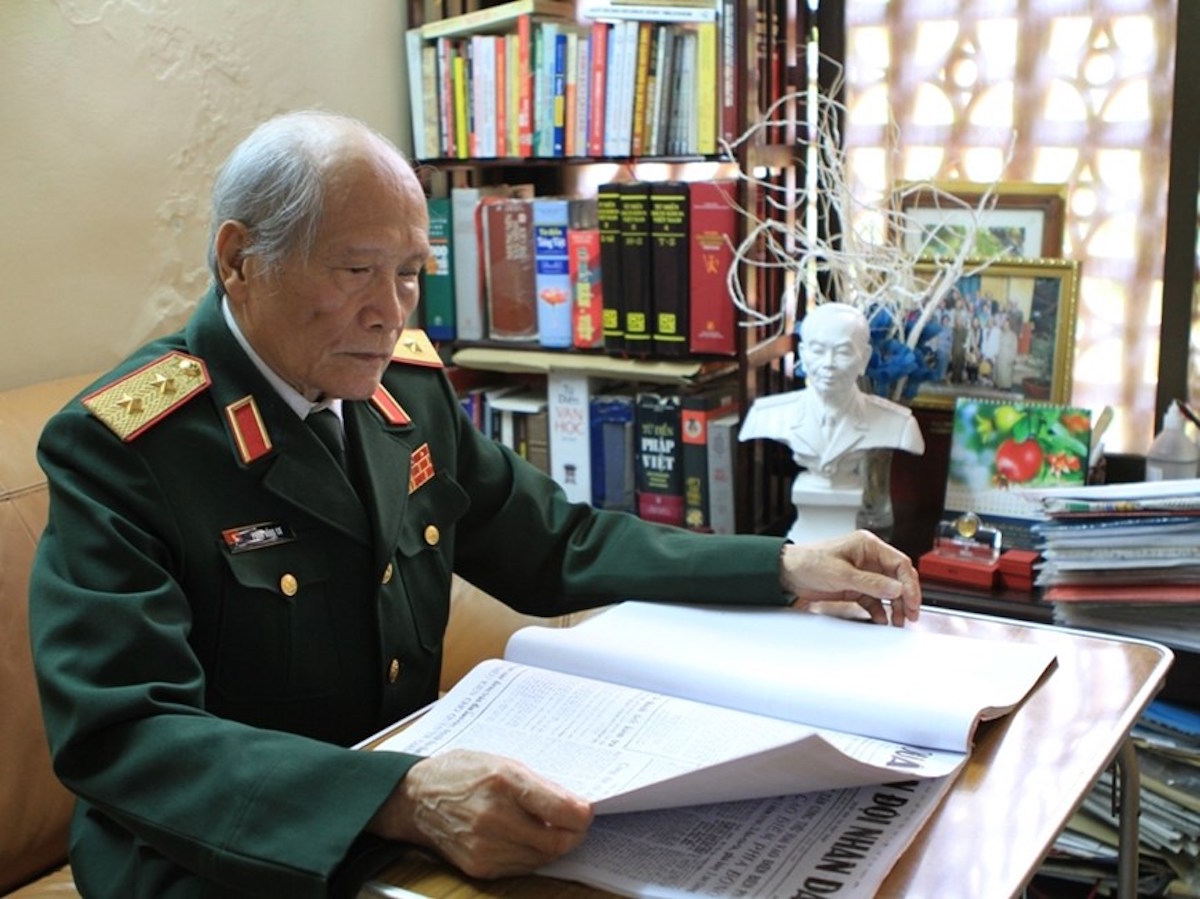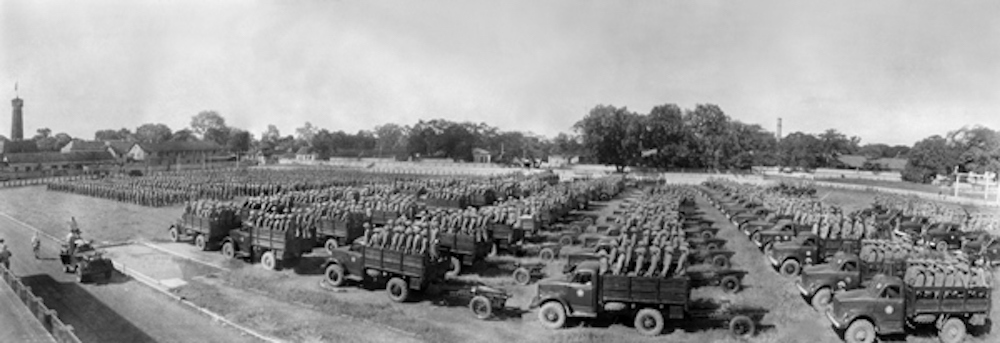“Waves of troops are marching/Units of the army are returning/We feel the joy when the enemy surrenders/The flags of the old day are now streaming on streets/We are engulfed in the song, the bayonets are sparkling/We have regained the glory and strength of the nation/The whole joyful life has returned…” (an excerpt from the song “Tien ve Ha Noi” (Marching to Hanoi) by Van Cao)
The date October 10, 1954 was a milestone that heralded a new era of Hanoi’s history. Since then, the capital city has undergone a path full of losses and pains but also glory and pride.
Sixty-five years have passed, but the memories of a time when the youth were engulfed in the simmering atmosphere of Hanoi’s army and people when taking over the capital remain intact in the minds of those involved.
Keeping the oath
Turning pages of a newspaper on which pictures have already become dull through time, Lt. Gen. Pham Hong Cu, former Vice Chairman of the General Department of Politics of the Vietnam People’s Army, recalled the scene of the capital in the autumn of 1954.

Clenching his hands, the old general recalled his military career. He was present throughout the two long struggles of the nation and witnessed many sacred moments of history. He said: “The destiny of I and people of my generation was linked to the nation’s destiny from the years of tenacious struggle to achieve victory in the Autumn Revolution in 1945. We are always proud of belonging to the generation that vowed to keep the independence and always exerted every effort to fulfill that oath.”
Six and a half decades ago, Cu was part of the revolutionary army that returned to take over Hanoi. “For compatriots across the country, it is the Capital Liberation Day. For us, it was also a historic returning day, the day to fulfill the vow: ‘Leaving to promise a returning day’,” he said.
On the tens-of-thousands-of-miles odyssey to fight against the French colonialists, we always dreamed of coming back to Hanoi and imagined the day of returning as the victors.
The memories come rushing back like a slow-motion film to the soldier of the then Vanguard Division 308. On February 17, 1947, after 60 days and nights of fighting in the spirit of “Determined to brave death for the survival of the Fatherland “, the Capital Regiment withdrew from Hanoi to preserve its forces and prepare for a long-term resistance war.
In their mind, every officer and soldier was always filled with nostalgia for Hanoi. “On the tens-of-thousands-of-miles odyssey to fight against the French colonialists, we always dreamed of coming back to Hanoi and imagined the day of returning as the victors,” the old general said emotionally.
During the resistance war against France, Cu was a commissar of Binh Ca Battalion and Vice Political Commissar of Regiment 36 under Brigade 308. He directly took part in many major campaigns, including the Dien Bien Phu Campaign.
The victory of the Vietnamese army and people in the Dien Bien Phu Campaign forced the French colonialists to come to the negotiating table and sign the Geneva Accords on July 21, 1954, to recognise the independence, sovereignty and territorial integrity of the three Indochinese nations (Vietnam, Laos and Cambodia) and withdraw troops from the north of Vietnam.
Under the terms of this agreement, Hanoi was part of the assembly area of the French troops in 80 days.
“In anticipation of the French colonialists’ conspiracy (taking advantage of this time to destroy economic, cultural and social facilities…), the takeover of the capital was planned quickly and prepared carefully. On September 17, 1954, the Hanoi Political and Military Committee was established,” said Lt. Gen. Pham Hong Cu.

In September 1954, regiments of Brigade 308 gathered near Hanoi. He recounted: “Around mid-September of that year, I received a summoning order to reverse the direction the troops advancing to receive instructions from our superiors. On September 19, 1954, at Hung Kings Temple (in Phu Tho province), I was one of the officers and soldiers to have the honour to meet President Ho Chi Minh to listen to his directions and assignment of the task of taking over the capital.”
Keeping silent for a few minutes, the old general went on to say that he still remembers the scene on that day, when the president sat on the steps of Gieng Temple, graciously telling officers and soldiers taking over the capital to be united, strictly observe discipline, ensure security and order, protect the lives and property of the people, and resolutely fight against all sabotage acts of the enemy…
“In particular, the Uncle told us to stay close to the people, so that people from the old to small children will understand, trust and love the soldiers. He said: ‘The Hung Kings had the merit of building the country, we must together safeguard it.’ That instruction was like the proclamation of the nation that resounded in the minds of the Vietnamese people,” Cu recalled.

Glory of the returning day
Continuing his story, the soldier joining the troops that took over the capital in the past said the special coincidence of history brought much honour and good luck to his military life.
He noted: “I used to be a commissar of Binh Ca Battalion, the first generation of the Capital Regiment. Binh Ca Battalion was the first unit to withdraw from Hanoi in 1947 and was also the first to take over the capital in 1954. The witnesses of both events, ‘withdrawing’ and ‘returning’, like us have a special feeling: both joy and pain because many comrades and people had to lay down their lives in the odyssey to bring the glory back.”
On October 8, 1954, Binh Ca Battalion (of the Capital Regiment, Brigade 308) entered Duong Bridge, becoming the first military unit to advance to Hanoi with the task of receiving the French troops’ bases and ensuring the safety for the entire army which would take over the capital on October 10, 1954.

At that time, Binh Ca Battalion was divided into 35 groups to take over 35 positions occupied by French troops. At the United Armistice Committee (located at Don Thuy Hospital, now Central Military Hospital 108), as the victors, the Vietnamese troops chanted the slogan “Long live peace!” and took the initiative to show the goodwill by putting flowers at the top of their guns…
At 5am of October 10, 1954, when the curfew ended, the whole city burst with joy and became animated. Tens of thousands of local residents happily welcomed the victorious army. The city’s Political and Military Committee and military units (including infantry, artillery, and anti-aircraft…) split into many groups to begin the historical march to Hanoi.
At 5am on October 10, 1954, when the curfew ended, the whole city burst with joy and became animated. Tens of thousands of local residents happily welcomed the victorious army.
“On that day, streets became jubilant and colorful with flags and banners. It seemed that everyone wore the best and most beautiful clothes to celebrate the big day. At about 8 o’clock, the revolutionary soldiers in uniform with shirts attached with the ‘Dien Bien Phu Soldier’ badge returned to Hanoi in the warm and joyful welcome of the people. Wherever the soldiers went, cheers resounded like waves. The smiles mixed with tears, the firm handshakes, and the radiant eyes of the capital’s people welcomed the revolutionary army,” Cu recounted.

Historic flag saluting ceremony
On October 10, 1954, Hanoi became free of the enemy. One of the most sacred moments was the first flag saluting ceremony organised by the city’s Political and Military Committee after the capital liberation.
Looking back on the historic flag saluting ceremony, Lt. Gen. Pham Hong Cu said at 3pm of October 10, 1954, the horn at the Opera House made a long sound. The national flag fluttered on the flag tower of Hanoi. On the Cot Co yard (now part of the Imperial Citadel of Thang Long relic site), infantry, motor vehicle and artillery units gathered solemnly.

In the old general’s memory, at that time, people crowded the outer area (Hoang Dieu street and Dien Bien Phu street today), their eyes filled with tears looking at the flag flying against the blue sky. People across city turned their hearts towards the ceremony.
At 3pm of October 10, 1954, the horn at the Opera House made a long sound. The national flag fluttered on the flag tower of Hanoi.
Lt. Gen. Cu recounted after the music sounded, all the soldiers and people attentively listened to Maj. Gen. Vuong Thua Vu, Chairman of the Hanoi Political and Military Committee, reading President Ho Chi Minh’s message for Hanoians: “Over the past eight years, the Government had to leave the capital to fight to save the country. Despite being far apart, the Government is always near the compatriots. Today, thanks to the solidarity and unanimity of our people, our army fought heroically and the resistance war came to success, the Government returns to the capital to reunite with the people.”

“After the flag raising ceremony, people spread across the streets. Uncle Ho’s words still echoed in the minds of Hanoians: ‘After the transformation, the restoration of the normal life will be more complicated and difficult. With the resolve of the Government and all Hanoi people’s unanimity to join hands with the Government, we will certainly overcome all difficulties and achieve the common goal of turning Hanoi into a peaceful, happy and prosperous capital’,” Cu added./.

